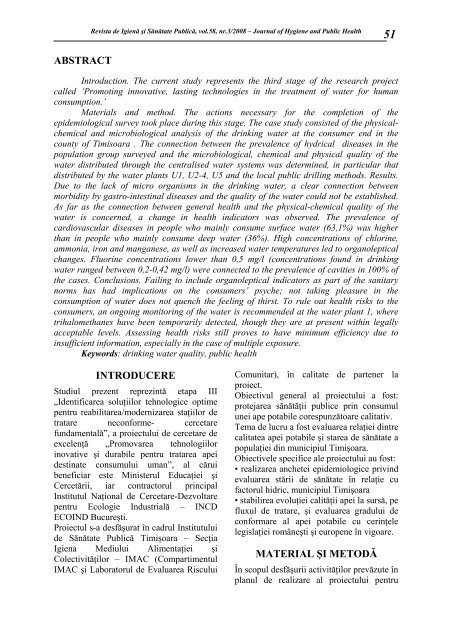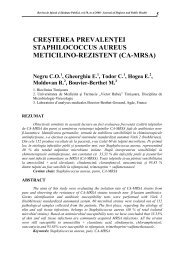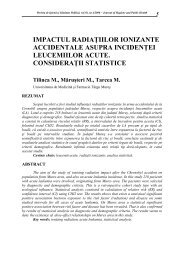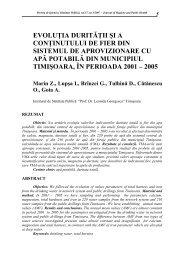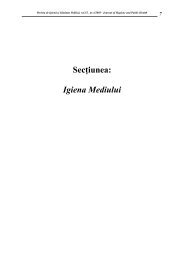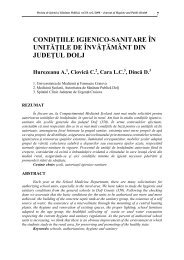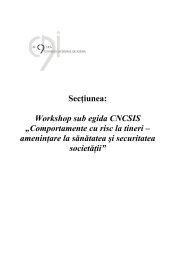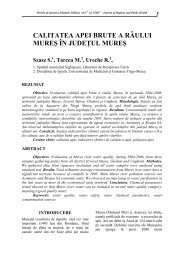poluarea aerului cu pulberi - Revista de Igiena si Sanatate Publica
poluarea aerului cu pulberi - Revista de Igiena si Sanatate Publica
poluarea aerului cu pulberi - Revista de Igiena si Sanatate Publica
You also want an ePaper? Increase the reach of your titles
YUMPU automatically turns print PDFs into web optimized ePapers that Google loves.
ABSTRACT<br />
<strong>Revista</strong> <strong>de</strong> Igienă şi Sănătate Publică, vol.58, nr.3/2008 – Journal of Hygiene and Public Health 51<br />
Introduction. The <strong>cu</strong>rrent study represents the third stage of the research project<br />
called ‘Promoting innovative, lasting technologies in the treatment of water for human<br />
consumption.’<br />
Materials and method. The actions necessary for the completion of the<br />
epi<strong>de</strong>miological survey took place during this stage. The case study con<strong>si</strong>sted of the phy<strong>si</strong>calchemical<br />
and microbiological analy<strong>si</strong>s of the drinking water at the consumer end in the<br />
county of Timisoara . The connection between the prevalence of hydrical diseases in the<br />
population group surveyed and the microbiological, chemical and phy<strong>si</strong>cal quality of the<br />
water distributed through the centralised water systems was <strong>de</strong>termined, in parti<strong>cu</strong>lar that<br />
distributed by the water plants U1, U2-4, U5 and the local public drilling methods. Results.<br />
Due to the lack of micro organisms in the drinking water, a clear connection between<br />
morbidity by gastro-intestinal diseases and the quality of the water could not be established.<br />
As far as the connection between general health and the phy<strong>si</strong>cal-chemical quality of the<br />
water is concerned, a change in health indicators was observed. The prevalence of<br />
cardiovas<strong>cu</strong>lar diseases in people who mainly consume surface water (63,1%) was higher<br />
than in people who mainly consume <strong>de</strong>ep water (36%). High concentrations of chlorine,<br />
ammonia, iron and manganese, as well as increased water temperatures led to organoleptical<br />
changes. Fluorine concentrations lower than 0,5 mg/l (concentrations found in drinking<br />
water ranged between 0,2-0,42 mg/l) were connected to the prevalence of cavities in 100% of<br />
the cases. Conclu<strong>si</strong>ons. Failing to inclu<strong>de</strong> organoleptical indicators as part of the sanitary<br />
norms has had implications on the consumers’ psyche; not taking pleasure in the<br />
consumption of water does not quench the feeling of thirst. To rule out health risks to the<br />
consumers, an ongoing monitoring of the water is recommen<strong>de</strong>d at the water plant 1, where<br />
trihalomethanes have been temporarily <strong>de</strong>tected, though they are at present within legally<br />
acceptable levels. Asses<strong>si</strong>ng health risks still proves to have minimum efficiency due to<br />
insufficient information, especially in the case of multiple exposure.<br />
Keywords: drinking water quality, public health<br />
INTRODUCERE<br />
Studiul prezent reprezintă etapa III<br />
„I<strong>de</strong>ntificarea soluţiilor tehnologice optime<br />
pentru reabilitarea/mo<strong>de</strong>rnizarea staţiilor <strong>de</strong><br />
tratare neconforme- cercetare<br />
fundamentală”, a proiectului <strong>de</strong> cercetare <strong>de</strong><br />
excelenţă „Promovarea tehnologiilor<br />
inovative şi durabile pentru tratarea apei<br />
<strong>de</strong>stinate consumului uman”, al cărui<br />
beneficiar este Ministerul Educaţiei şi<br />
Cercetării, iar contractorul principal<br />
Institutul Naţional <strong>de</strong> Cercetare-Dezvoltare<br />
pentru Ecologie Industrială – INCD<br />
ECOIND Bu<strong>cu</strong>reşti.<br />
Proiectul s-a <strong>de</strong>sfăşurat în cadrul Institutului<br />
<strong>de</strong> Sănătate Publică Timişoara – Secţia<br />
<strong>Igiena</strong> Mediului Alimentaţiei şi<br />
Colectivităţilor – IMAC (Compartimentul<br />
IMAC şi Laboratorul <strong>de</strong> Evaluarea Ris<strong>cu</strong>lui<br />
Comunitar), în calitate <strong>de</strong> partener la<br />
proiect.<br />
Obiectivul general al proiectului a fost:<br />
protejarea sănătăţii publice prin consumul<br />
unei ape potabile corespunzătoare calitativ.<br />
Tema <strong>de</strong> lucru a fost evaluarea relaţiei dintre<br />
calitatea apei potabile şi starea <strong>de</strong> sănătate a<br />
populaţiei din municipiul Timişoara.<br />
Obiectivele specifice ale proiectului au fost:<br />
• realizarea anchetei epi<strong>de</strong>miologice privind<br />
evaluarea stării <strong>de</strong> sănătate în relaţie <strong>cu</strong><br />
factorul hidric, municipiul Timişoara<br />
• stabilirea evoluţiei calităţii apei la sursă, pe<br />
fluxul <strong>de</strong> tratare, şi evaluarea gradului <strong>de</strong><br />
conformare al apei potabile <strong>cu</strong> cerinţele<br />
legislaţiei româneşti şi europene în vigoare.<br />
MATERIAL ŞI METODĂ<br />
În scopul <strong>de</strong>sfăşurii activităţilor prevăzute în<br />
planul <strong>de</strong> realizare al proiectului pentru


